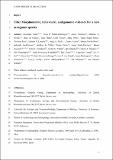Morphometric, behavioral, and genomic evidence for a new orangutan species
Abstract
Six extant species of non-human great apes are currently recognized: Sumatran and Bornean orangutans, eastern and western gorillas, and chimpanzees and bonobos [1]. However, large gaps remain in our knowledge of fine-scale variation in hominoid morphology, behavior, and genetics, and aspects of great ape taxonomy remain in flux. This is particularly true for orangutans (genus: Pongo), the only Asian great apes and phylogenetically our most distant relatives among extant hominids [1]. Designation of Bornean and Sumatran orangutans, P. pygmaeus (Linnaeus 1760) and P. abelii (Lesson 1827), as distinct species occurred in 2001 [1, 2]. Here, we show that an isolated population from Batang Toru, at the southernmost range limit of extant Sumatran orangutans south of Lake Toba, is distinct from other northern Sumatran and Bornean populations. By comparing cranio-mandibular and dental characters of an orangutan killed in a human-animal conflict to those of 33 adult male orangutans of a similar developmental stage, we found consistent differences between the Batang Toru individual and other extant Ponginae. Our analyses of 37 orangutan genomes provided a second line of evidence. Model-based approaches revealed that the deepest split in the evolutionary history of extant orangutans occurred ∼3.38 mya between the Batang Toru population and those to the north of Lake Toba, whereas both currently recognized species separated much later, about 674 kya. Our combined analyses support a new classification of orangutans into three extant species. The new species, Pongo tapanuliensis, encompasses the Batang Toru population, of which fewer than 800 individuals survive.
Citation
Nater , A , Mattle-Greminger , M P , Nurcahyo , A , Nowak , M G , de Manuel , M , Desai , T , Groves , C , Pybus , M , Sonay , T B , Roos , C , R. Lameira , A , Wich , S A , Askew , J , Davila-Ross , M , Fredriksson , G , de Valles , G , Casals , F , Prado-Martinez , J , Goossens , B , Verschoor , E J , Warren , K S , Singleton , I , Marques , D A , Pamungkas , J , Perwitasari-Farajallah , D , Rianti , P , Tuuga , A , Gut , I G , Gut , M , Orozco-terWengel , P , van Schaik , C P , Bertranpetit , J , Anisimova , M , Scally , A , Marques-Bonet , T , Meijaard , E & Krützen , M 2017 , ' Morphometric, behavioral, and genomic evidence for a new orangutan species ' , Current Biology , vol. 27 , no. 22 . https://doi.org/10.1016/j.cub.2017.09.047
Publication
Current Biology
Status
Peer reviewed
ISSN
0960-9822Type
Journal article
Description
This work was financially supported by University of Zurich (UZH) Forschungskredit grants FK-10 (M.P.M.-G.), FK-15-103 (A. Nater), and FK-14-094 (T.B.S.), Swiss National Science Foundation grant 3100A-116848 (M.K.and C.P.v.S.), the Leakey Foundation (M.P.M.-G.), the A.H. Schultz Foundation (M.K. and M.P.M.-G.), UZH Research Priority Program “Evolution in Action” (M.K.), Arcus Foundation grant G-PGM-1411-1112 (E.M.), Australian National University (ANU) research fund (A. Nurcahyo), an ANU Vice Chancellor Travel Grant (A. Nurcahyo), Australia Awards Scholarship-DFAT (A. Nurcahyo), ERC Starting Grant 260372 (T.M.-B.), EMBOYIP 2013 (T.M.-B.), MINECOBFU2014-55090-P, BFU2015-7116-ERC, BFU2015-6215-ERCU01, and MH106874 (T.M.-B.), Fundacio Zoo Barcelona (T.M.-B.), Julius–Klaus Foundation (M.K.), MINECO/FEDERBFU2016-77961-P (J.B. and M.P.), Gates Cambridge Trust (T.D.), and the Department of Anthropology at the University of Zurich.Collections
Items in the St Andrews Research Repository are protected by copyright, with all rights reserved, unless otherwise indicated.

